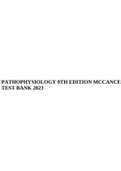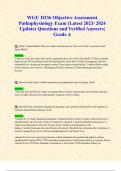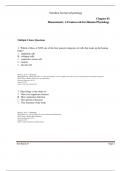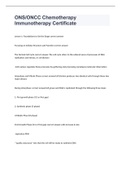Cells and proteins Study guides, Class notes & Summaries
Looking for the best study guides, study notes and summaries about Cells and proteins? On this page you'll find 26213 study documents about Cells and proteins.
All 26.213 results
Sort by

-
Porth’s Essentials Of Pathophysiology 5th Edition Test Bank with Rationales | Complete Guide A+
- Exam (elaborations) • 600 pages • 2023
-
- $24.99
- 22x sold
- + learn more
Porth’s Essentials Of Pathophysiology 5th Edition Test Bank 1. Chapter 1 Although the basic structure of the cell plasma membrane is formed by a lipid bilayer, most of the specific membrane functions are carried out by: A) Bound and transmembrane proteins B) Complex, long carbohydrate chains C) Surface antigens and hormone receptors D) A gating system of selective ion channels Ans: A Feedback: The functions of plasma membrane depend on the presence of proteins that are bound in the lipid bilay...

-
FULL TEST BANK For McCance & Huether’S Pathophysiology 9th Edition, THE BIOLOGICAL BASIS FOR DISEASE IN ADULTS AND CHILDREN, BY JULIA L. ROGERS ;Fully Completed, 2023-2024, ISBN-13: 9780323789882, CHAPTER 1-49, NEWEST VERSION
- Exam (elaborations) • 499 pages • 2023 Popular
- Available in package deal
-
- $16.49
- 11x sold
- + learn more
UNIT I: The Cell Chapter 01: Cellular Biology 4 Chapter 02: Altered Cellular and Tissue Biology: Environmental Agents 18 Chapter 03: The Cellular Environment: Fluids and Electrolytes, Acids and Bases 31 UNIT II: Gene and Gene Environment interaction Chapter 04: Genes and Genetic Diseases 44 Chapter 05: Genes, Environment-Lifestyle, and Common Diseases 55 Chapter 06: Epigenetics and Disease 63 UNIT III: Mechanisms of Self-defence Chapter 07: Innate Immunity: Inflammation and Wound Healin...

-
Exam 3: NSG530/ NSG 530 (Latest 2023/ 2024) - Advanced Pathophysiology Exam Review| Guide with Questions and Verified Answers| 100% Correct
- Exam (elaborations) • 47 pages • 2023
-
Available in package deal
-
- $10.99
- 5x sold
- + learn more
Exam 3: NSG530/ NSG 530 (Latest 2023/ 2024) - Advanced Pathophysiology Exam Review| Guide with Questions and Verified Answers| 100% Correct Q: the stomach is impermeable to what? Answer: water, but can absorb alcohol and aspirin as they are lipid soluble. Q: blood to stomach is supplied by ? Answer: celiac artery- abundant! Q: Three phases of gastric secretion Answer: lic phase ic phase tinal phase Q: Motilin Answer: increases peristalsis Q...

-
PATHOPHYSIOLOGY 9TH EDITION MCCANCE TEST BANK 2023.
- Exam (elaborations) • 493 pages • 2023
- Available in package deal
-
- $27.99
- 17x sold
- + learn more
PATHOPHYSIOLOGY 9TH EDITION MCCANCE TEST BANK 2023. Chapter 1: Cellular Biology MULTIPLE CHOICE 1. Which statement best describes the cellular function of metabolic absorption? a. Cells can produce proteins. c. Cells can take in and use nutrients. b. Cells can secrete digestive enzymes. d. Cells can synthesize fats. ANS: C In metabolic absorption, all cells take in and use nutrients and other substances from their surroundings. The remaining options are not inclusive in their description...

-
Exam 4: NUR230/ NUR 230 (Latest 2023/ 2024) The Childbearing/Child Caring Family Exam Review| Questions and Verified Answers| 100% Correct- Galen
- Exam (elaborations) • 32 pages • 2023
-
Available in package deal
-
- $10.99
- 3x sold
- + learn more
Exam 4: NUR230/ NUR 230 (Latest 2023/ 2024) The Childbearing/Child Caring Family Exam Review| Questions and Verified Answers| 100% Correct- Galen Q: sickle cell anemia Answer: a genetic disorder that causes abnormal hemoglobin, re- sulting in some red blood cells assuming an abnormal sickle shape Hereditary presence of HbS; autosomal recessive trait Q: sickle cell anemia diagnostics Answer: Newborn screening Q: Sickle Cell Crisis cause Answer: infec...

-
WGU D236 Objective Assessment Pathophysiology Exam (Latest 2023/ 2024 Update) Questions and Verified Answers| Grade A
- Exam (elaborations) • 30 pages • 2023
-
Available in package deal
-
- $10.99
- 6x sold
- + learn more
WGU D236 Objective Assessment Pathophysiology Exam (Latest 2023/ 2024 Update) Questions and Verified Answers| Grade A Q: What is Spina Bifida? Why are relative deficiencies in Folic acid or B12 associated with Spina Bifida? Answer: Failure to close the neural tube early in gestation due to low folic acid and B-12 These vitamins help activate DNA synthesis in the developing fetus in the first 4 weeks of pregnancy, that are responsible for closing up the spinal column. Three types of spina...

-
Test bank for vanders human physiology 15th edition complete and Updated A+
- Exam (elaborations) • 780 pages • 2023
-
- $12.99
- 6x sold
- + learn more
Test bank for vanders human physiology 15th edition complete and Updated A+ Chapter 01 Homeostasis: A Framework for Human Physiology Multiple Choice Questions 1. Which of these is NOT one of the four general categories of cells that make up the human body? A. epithelial cells B. collagen cells C. connective tissue cell D. neuron E. muscle cell Bloom's: Level: 1. Remember HAPS Objective: A06.01 Describe, in order from simplest to most complex, the major levels of organization in the human organi...

-
NSG530 / NSG 530 Exam 3 (Latest 2024 / 2025): Advanced Pathophysiology | Review Guide with Questions and Verified Answers | 100% Correct - Wilkes
- Exam (elaborations) • 99 pages • 2024
- Available in package deal
-
- $7.99
- 3x sold
- + learn more
Exam 3: NSG530 / NSG 530 (Latest 2024 / 2025) - Advanced Pathophysiology Exam Review | Guide with Questions and Verified Answers | 100% Correct - Wilkes Q: the stomach is impermeable to what? Answer: water, but can absorb alcohol and aspirin as they are lipid soluble. Q: blood to stomach is supplied by ? Answer: celiac artery- abundant! Q: Three phases of gastric secretion Answer: lic phase ic phase tinal phase Q: Motilin Answer: increases peristalsis Q: Secretin Answer: decreases peristalsis Q:...

-
Exam 3: BIOS 242 / BIOS242 Review (Latest 2024/ 2025 Update) Fundamentals of Microbiology with Lab| Questions and Verified Answers| 100% Correct| Grade A- Chamberlain
- Exam (elaborations) • 29 pages • 2024
-
Available in package deal
-
- $10.99
- 2x sold
- + learn more
Exam 3: BIOS 242 / BIOS242 Review (Latest 2024/ 2025 Update) Fundamentals of Microbiology with Lab| Questions and Verified Answers| 100% Correct| Grade A- Chamberlain Q: what is an antigen? foreign molecule that causes a specific immune response Q: what is another name for antigens? Answer: immunogens Q: where do antigens come from? Answer: proteins and polysaccharides from cells and viruses Q: what are the functions of plasmid cells? Answer: release antibodies...

-
ONS/ONCC Chemotherapy Immunotherapy Certificate exam 2022/2023 with 100% correct answers
- Exam (elaborations) • 28 pages • 2022
-
Available in package deal
-
- $11.49
- 19x sold
- + learn more
Lesson 1: Foundations to Set the Stage ... Focusing on Cellular Structure and Function ... The Normal Cell Cycle -The cell cycle refers to the ordered seres of processes of DNA replication and mitosis, or cell division -Cell nucleus regulates these processes by gathering and processing complexes molecular information Interphase and Mitotic Phase Cell division produces two identical cells through these two major phases During interphase: Cell grows and DNA is r...

How did he do that? By selling his study resources on Stuvia. Try it yourself! Discover all about earning on Stuvia


